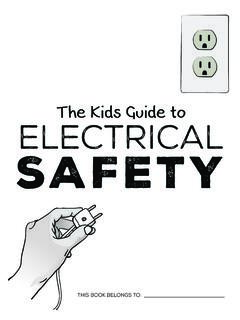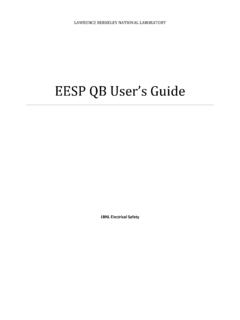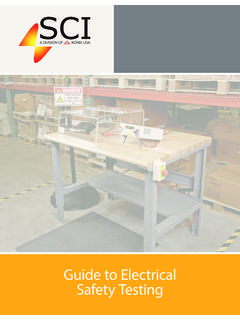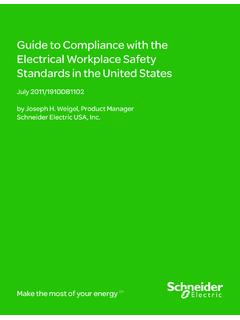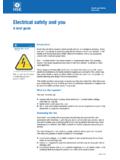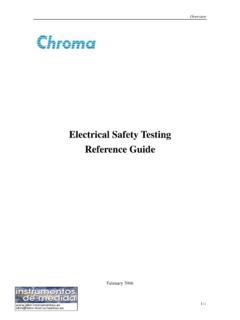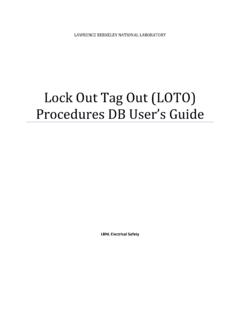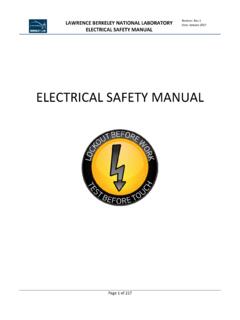Transcription of Safety guidance Landlords’ guide to electrical safety
1 Landlords guide toelectricalsafetyEngland & WalesSafety 3 Why you need this guideand how it can help you The law 4and what you need to knowElectrical installations 6 Certification 8of electrical installation workPeriodic inspection, 9testing and conditionreportingElectrical appliances 11 Fire alarms 13 Emergency lighting 14 Finding an electrician 15123456789 Typical examples ofpotentially dangerouselectrical installations3 Introduction Why you need this guide and how it can help you1 Data supplied by the Department for Communities and Local Government, 15/02 Britain has a relatively good record of electrical Safety but the most recent figures available show that in a typical year: Around 20 people will die as a result of electrocution and/or fatal electric burns suffered at home.
2 There will be approximately 20,000 accidental electrical fires in homes, resulting in around 50 deaths and 3500 Safety First has produced this guide to help landlords understand their responsibilities for electrical Safety in their rental properties and to provide practical advice on what is required to ensure the Safety of accidents involving electricity in the home arise through faults in, or misuse of, domestic appliances or the electrical installation. Another major cause is objects being placed too close to a heat source, such as an electric heater or lamp. In 2010 for example, this resulted in 151 deaths and many serious burn three major hazards from electricity in the home are electric shock, fire and can occur through: The electrical installation and equipment deteriorating over time.
3 Damage to switches, sockets and other equipment. Misuse of the installation and equipment. Poor or lack of maintenance of the installation and equipment. have a legal duty to ensure that their rental property, and any electrical equipment provided, is safe before a tenancy begins and throughout its Landlord and Tenant Act 1985 is the main legislation for landlords in England and Wales. Key points can be found in:Section 8. Implied terms as to fitness for human habitation The property should be fit for people to live in at the beginning of the tenancy (subsection (1)(a)). The property should be kept in a fit state for people to live in during the tenancy (subsection (1)(b)).
4 Section 11. Repairing obligations in short leasesThis places a duty on landlords to keep in repair and proper working order the: Installations in the property for the supply of water, gas and electricity, and for sanitation (subsection (1)(b)). Space heating and heating water (subsection (1)(c)).Two other Acts the Occupiers Liability Act 1957 and Occupiers Liability Act 1984 give landlords a duty of care for anyone visiting their property. In short, a landlord could be prosecuted if someone is injured on their land or premises regardless of whether the visitor is there lawfully (the 1957 Act) or trespassing (the 1984 Act.)In January 2005, the Building Regulations for England and Wales were amended to include Part P, which covers electrical Safety in dwellings.
5 This means that all electrical installation work undertaken in a home in England or Wales must, by law, comply with Part P of the Building Regulations. This requires reasonable in the design and installation of electrical installations ..to protect persons operating, maintaining or altering the installations from fire or injury .Except for some types of minor work, if you intend to carry out electrical installation work in domestic premises, you must either: notify a building control body (usually your local authority building control department) before the work starts, or have it carried out by an electrician who is registered with one of the Government-authorised Part P competent person scheme operators, orThe law and what you need to know25 In England, have the work inspected and tested by a registered third party information can be found in.
6 For England, Approved Document P (2013 edition) Wales, Approved Document P (2006 edition with 2010 amendments) October 2006, the Regulatory Reform (Fire Safety ) Order 2005 (England and Wales) became law. It replaces most previous fire Safety legislation and applies to all non-domestic premises, including common parts of blocks of flats, and houses in multiple occupation (HMOs). guidance on carrying out a fire Safety risk assessment for sleeping accommodation can be downloaded free from: areasA landlord is also responsible for the communal areas of a house, block of flats, or an estate that residents use in common with other tenants, such as: Entrance halls and foyers.
7 Lifts and stairwells. Corridors. Landings. Kitchens and bathrooms. Laundries. Gymnasiums. Swimming pools and other leisure facilities. Parking and refuse areas. Pathways. Alarms and CO DetectorsFrom 1st October 2015, when properties are occupied by tenants, the landlord must ensure that: a smoke alarm is equipped on each storey of the premises on which there is a room used wholly or partly as living accommodation; a carbon monoxide alarm is equipped in any room of the premises which is used wholly or partly as living accommodation and contains a solid fuel burning combustion appliance; Checks must be made by or on behalf of the landlord to make sure that each prescribed alarm is in proper working order on the day the tenancy begins (if it is a new tenancy).
8 The full legislation can be found electrical installation comprises all the fixed electrical equipment that is supplied through the electricity meter. It includes the cables that are usually hidden in the walls and ceilings, accessories (such as sockets, switches and light fittings), and the consumer unit (fusebox) that contains all the fuses, circuit breakers and, preferably residual current devices (RCDs). 2 Over time, and with the wear and tear of regular use, the installation will start to deteriorate. Connections can work loose (a potential fire hazard), equipment can be damaged, and building and maintenance work can have an impact on the An RCD (residual current device) is a life-saving device which is designed to prevent you from getting a fatal electric shock if you touch something live, such as a bare wire.
9 It provides a level of protection that ordinary fuses or circuit breakers are many factors that contribute to a good electrical installation, such as ensuring: There are enough sockets for electrical appliances, to minimise the use of multiway socket adapters and trailing leads. Covers are in place to prevent fingers coming into contact with live parts (broken or damaged switches and sockets should be replaced without delay). A residual current device (RCD) is installed to provide additional protection against electric shock (see also Section 6 of this guide ). Satisfactory earthing arrangements are in place to ensure that a fuse or circuit breaker can quickly clear an electrical fault before it causes an electric shock or fire.
10 Satisfactory protective bonding arrangements are in place where required (so any electric shock risk is minimised until a fault is cleared). Sufficient circuits are provided to avoid danger and minimise inconvenience in the event of a fault. Cables are correctly selected and installed in relation to the fuse or circuit-breaker protecting the installations37 electrical Safety First has also produced an App to assist those carrying out visual Safety checks on a domestic property which can be downloaded from and advice/around the home/visual checks/(see also Section 5 of this guide ).Use the Home electrical Safety Check app. One simple thing you can do to see if your electrical installation is safe, is to carry out a regular visual check.


